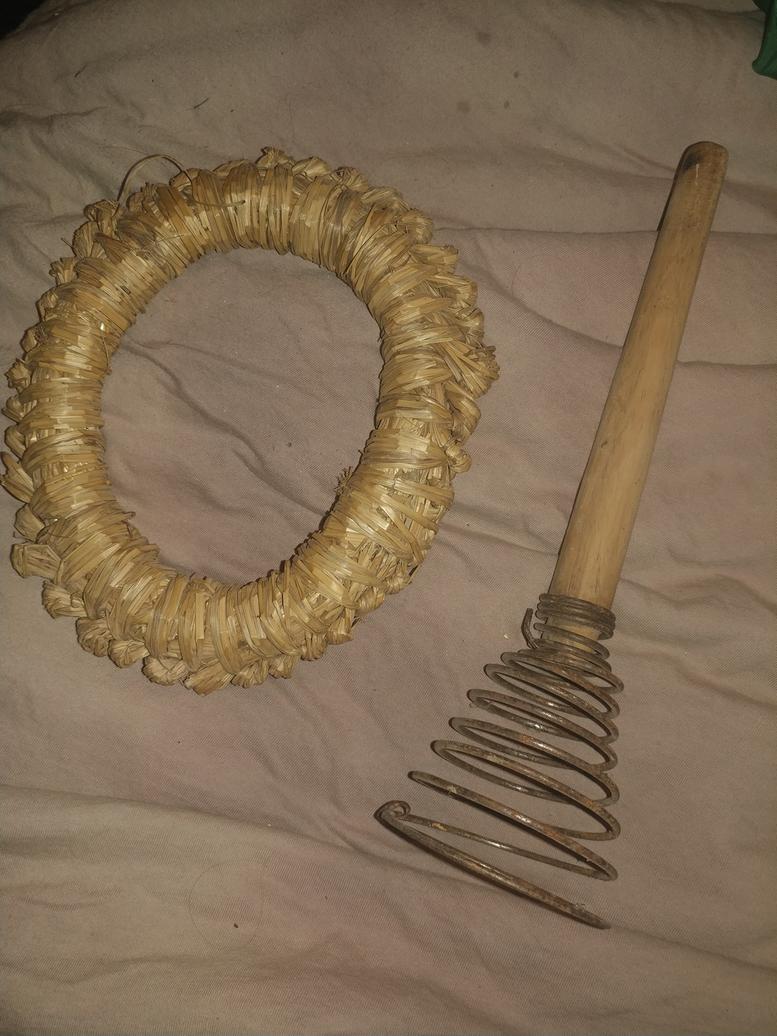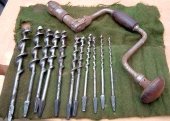
 28
28




Gardens in my mind never need water
Castles in the air never have a wet basement
Well made buildings are fractal -- equally intelligent design at every level of detail.
Bright sparks remind others that they too can dance
What I am looking for is looking for me too!

Farther down https://permies.com/t/268916/tech/Carrying-head#2806347
I talk about how to build up your muscles to carry things without getting hurt. If you have never carried things on your head, be sure to read that post! Neck damage is not something you want.
 11
11




Best luck: satisfaction
Greatest curse, greed
 11
11




Invasive plants are Earth's way of insisting we notice her medicines. Stephen Herrod Buhner
Everyone learns what works by learning what doesn't work. Stephen Herrod Buhner
 29
29




Anne Miller wrote:There is a textile ring that is used to carry heavy objects on the head.











How permies.com works
What is a Mother Tree ?
 22
22




How permies.com works
What is a Mother Tree ?
 17
17




 20
20




Gardens in my mind never need water
Castles in the air never have a wet basement
Well made buildings are fractal -- equally intelligent design at every level of detail.
Bright sparks remind others that they too can dance
What I am looking for is looking for me too!

 13
13




"The only thing...more expensive than education is ignorance."~Ben Franklin. "We can easily forgive a child who is afraid of the dark; the real tragedy of life is when men are afraid of the light." ~ Plato
 16
16




Carla Burke wrote:What advice would you give people wanting to begin caring things, this way? I can't help thinking the rings would be particularly important, but how does one decide how big in diameter and thickness? Is it best to have several, in varying sizes? Is there some method to strengthening the muscles to safely and efficiently carry on the head? Are there any precautions, beyond the obvious ones (I'd think things like carrying sharp objects or things with sharp corners, it would be obvious to take extra precautions or just not do it, lol)? My head is more oval than round - would that make a difference in needed size/ shape of the ring?
Gardens in my mind never need water
Castles in the air never have a wet basement
Well made buildings are fractal -- equally intelligent design at every level of detail.
Bright sparks remind others that they too can dance
What I am looking for is looking for me too!

 14
14




Best luck: satisfaction
Greatest curse, greed
 4
4




"The only thing...more expensive than education is ignorance."~Ben Franklin. "We can easily forgive a child who is afraid of the dark; the real tragedy of life is when men are afraid of the light." ~ Plato
 9
9




 2
2




Carla Burke wrote:Hi, Thekla. Yup, of course. But, I always sucked at it, lol. I was thinking the rodihas would make it easier.
Best luck: satisfaction
Greatest curse, greed
 15
15




Douglas Alpenstock wrote:I admit it looks cool to see women (mostly?) balancing rather heavy loads on their heads.
Here's the contrarian view from a semi-retired wilderness backpacker. The hip bones, leg muscles, and supporting abdominal muscles is the best place on the human animal to handle significant weight. The spine just can't take it without damage, and that may not show up for many years. But ask anyone with back problems and, frankly, they will yell at you -- don't freaking do that!
I imagine walking with very light loads on the head would be great for posture -- it's a balance thing. My 2c.
Best luck: satisfaction
Greatest curse, greed
 12
12




"The only thing...more expensive than education is ignorance."~Ben Franklin. "We can easily forgive a child who is afraid of the dark; the real tragedy of life is when men are afraid of the light." ~ Plato
 11
11




 11
11




Best luck: satisfaction
Greatest curse, greed

 19
19




 15
15




Gardens in my mind never need water
Castles in the air never have a wet basement
Well made buildings are fractal -- equally intelligent design at every level of detail.
Bright sparks remind others that they too can dance
What I am looking for is looking for me too!

 10
10




Thekla McDaniels wrote:
Burra, and anyone else who knows, is rodihas plural? Would I be going to put one rodiha on my head?
How permies.com works
What is a Mother Tree ?
 15
15




Weeds are just plants with enough surplus will to live to withstand normal levels of gardening!--Alexandra Petri
 14
14




How permies.com works
What is a Mother Tree ?
 9
9




Pearl Sutton wrote: Practice on a smooth surface, walking with a light load (no more than a gallon of liquid) back and forth and turn and step, until you feel VERY balanced when you are walking that way. :D
Visit Redhawk's soil series: https://permies.com/wiki/redhawk-soil
How permies.com works: https://permies.com/wiki/34193/permies-works-links-threads
 8
8




Jay Angler wrote:
Pearl Sutton wrote: Practice on a smooth surface, walking with a light load (no more than a gallon of liquid) back and forth and turn and step, until you feel VERY balanced when you are walking that way. :D
I would suggest not starting out with a liquid, but rather something solid so the load doesn't wobble of its own accord?
Gardens in my mind never need water
Castles in the air never have a wet basement
Well made buildings are fractal -- equally intelligent design at every level of detail.
Bright sparks remind others that they too can dance
What I am looking for is looking for me too!

 9
9




Best luck: satisfaction
Greatest curse, greed
 5
5




Thekla McDaniels wrote:Hi Pearl,
I have carried things on my head, but I don’t have enough experience to give advice.
I carried a closed 5 gallon container of water. Many of the other women carried open containers of water. I find that really impressive!
One good thing I can say is that it’s very good for your posture and pelvic floor and abdominal muscles.
 18
18





Gardens in my mind never need water
Castles in the air never have a wet basement
Well made buildings are fractal -- equally intelligent design at every level of detail.
Bright sparks remind others that they too can dance
What I am looking for is looking for me too!

 17
17




"Ah, but a man's reach should exceed his grasp,
Or what's a heaven for?"
Andrea del Sarto by Robert Browning
 10
10




Kevin Olson wrote:While not strictly carrying a load on the head, a tump line can help to transfer some or most of the load of a packboard, backpack or pack basket to the top of the vertebral column. A tump line is basically a broad strap, which either passes under the load or is attached to it. The tump line passed either over the top of the head, just forward of the crown, or over the top of the forehead.
Tump lines were classic for the voyageurs to carry fur bales. Two ~70 pound bales were required to be carried by contract, but any "real man" carried three.

This carrying method can still be seen from time to time in canoe country, but with Duluth packs or traditional pack baskets, these days.

A spinet upright piano was packed over the Chilkoot Pass to make its way to a honky-tonk saloon in the Yukon gold fields with a tump line! The Chilkoot was pretty analogous to a via ferrata route.

Traditional tump lines are warp faced weave - like inkle loom goods.

As with the true head porter technique, it's sound advice to build up weight slowly.
Gardens in my mind never need water
Castles in the air never have a wet basement
Well made buildings are fractal -- equally intelligent design at every level of detail.
Bright sparks remind others that they too can dance
What I am looking for is looking for me too!

 7
7




Pearl Sutton wrote:A LOT of pictures out there of people using them with horrible posture. All pics below are off the net.

"Ah, but a man's reach should exceed his grasp,
Or what's a heaven for?"
Andrea del Sarto by Robert Browning
 15
15




 11
11




 10
10




Maieshe Ljin wrote:
I’m trying to figure out the best way to carry a tarp full of dead leaves, which has tended to flop over my face and make it hard to see. I probably should tie it up…
Gardens in my mind never need water
Castles in the air never have a wet basement
Well made buildings are fractal -- equally intelligent design at every level of detail.
Bright sparks remind others that they too can dance
What I am looking for is looking for me too!








 11
11




Hans Albert Quistorff, LMT projects on permies Hans Massage Qberry Farm magnet therapy gmail hquistorff
 7
7




Douglas Alpenstock wrote:Here's the contrarian view from a semi-retired wilderness backpacker. The hip bones, leg muscles, and supporting abdominal muscles is the best place on the human animal to handle significant weight. The spine just can't take it without damage...
Lif Strand
New Mexico USA
 7
7




 8
8




When an African or Indian village woman carries a heavy weight on her head (fig. 5-3), she is not passive under that weight, which would cause her discs to compress. Rather, she actively engages her inner corset ['contracting certain muscles in your abdomen and back']; her torso becomes more slender and her spine becomes longer. In this way she protects her discs from the weight she carries. ... Medical literature documents that in certain populations, such as the Bhil tribe of Central India, the discs of a 50-year-old look very similar to those of a 20-year-old (fig 5-5). The proper and frequent use of the inner corset muscles is perhaps why these populations experience virtually no disc degeneration as they age.
 10
10




 7
7





How permies.com works
What is a Mother Tree ?
 7
7






|
I claim this furniture in the name of The Ottoman Empire! You can keep this tiny ad:
Freaky Cheap Heat - 2 hour movie - HD streaming
https://permies.com/wiki/238453/Freaky-Cheap-Heat-hour-movie
|




